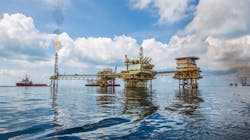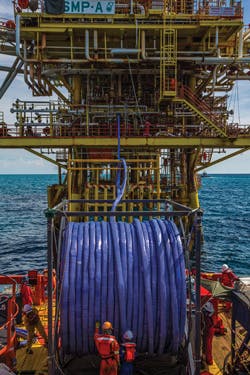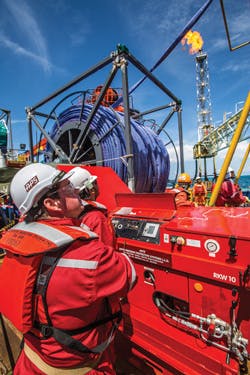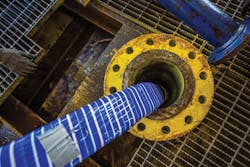New infield pipeline liner offers effective rehab option
Petronas deploys new system to preserve integrity of subsea lines
Robert Walters
Anticorrosion Protective Systems
A new liner comprised of thermoplastic fluoropolymers, polyurethanes, and Kevlar is available to the offshore pipeline market, and has been successfully deployed by Petronas Carigali (PCSB) on some of its subsea pipelines in the South China Sea.
Adapted from a liner originally developed for the onshore utility pipeline market, the new infield liner product is being developed for the offshore pipeline market by Anticorrosion Protective Systems (APS), a pipeline rehabilitation specialist engineering and contracting company.
Designed for harsh application pipelines, the deployment of these infield liners has enabled Petronas Carigali to re-commission several offshore pipelines that were shut down due to corrosion-related deterioration.
Battling internal corrosion
PCSB owns and operates an extensive network of subsea pipelines offshore Malaysia, in the South China Sea. Many of these pipelines are between several hundred meters to several kilometers in length, are in varying water depths and run from platform to platform, and from platform to onshore facilities.
Internal corrosion, due largely to sulfate reducing bacteria (SRB), can shorten pipeline life. Historically, this results in the need to replace such pipelines as often as in four years.
These types of relatively short lifecycles and frequent replacements represent substantial capex for PCSB. To reduce these costs and to extend pipeline life, the company began to support the development of in-situ corrosion barriers that could be successfully deployed for use in new and existing pipelines.
Historically, there has not been a viable way to install such a corrosion barrier within a subsea pipeline. But, PCSB's need to preserve and enhance the integrity of its offshore pipeline network led to the design and development of the infield liners (IFL) project.
IFL development project
The project began in April 2011 under the joint management of Petronas and APS. The project team delivered a market-ready product within two-years.
The goal of the project was to develop materials and technologies necessary to successfully install plastic liners into existing and new subsea carbon steel pipelines that convey corrosive hydrocarbon media, where SRB is one of the principal sources of corrosion. The IFL liner protects the internal pipe bore from corrosion and offers a secondary containment capability in the event of a rupture or damage to the outer steel pipeline.
The project started by testing an existing nominal 8-in. Kevlar reinforced plastic liner product, produced and manufactured by Raedlinger, Germany, for the utility market. Although this material had not been used to line subsea pipeline, the general liner matrix demonstrated many of the physical attributes necessary for success in such applications:
• High tensile and good physical properties
• Moderate chemical resistance
• A high degree of flexibility
• Ability to be manufactured and spooled in long lengths.
Liner qualification and development
The qualification of the liner was undertaken in accordance with the API Recommended 15S "Qualification of Spoolable Reinforced Plastic Line Pipe" (first edition March 2006), with further reference to the applicable ASTM test standards, API 17 series, and NACE standards. Testing and qualification were done in a number of locations including Germany, Norway, and the UAE.
The final enhanced IFL liner matrix is comprised of a Solvay Solexis PVDF (polyvinylidene difluoride) inner liner, a tightly woven aramid core using Dupont Kevlar fabric, with an outer layer of abrasive-resistant thermoplastic polyurethane from BASF. Other versions of the liner are available for less aggressive service conditions, such as water reinjection and gas transmission.
All the principal objectives of the project were fulfilled. A new, enhanced version of the IFL liner has been developed. Performance testing has completely justified the use of IFL in aggressive, hot, sour hydrocarbon service conditions of up to 120 ˚C (248 ˚F), with IFL liners exhibiting a stand-alone burst capability of up to 120 bar (1,740 psi).
Industry motivation
Most subsea pipelines are carbon steel installed by laybarge, during which single or double random joints of steel pipe are welded together on the deck of the barge and laid onto the seabed. After completion of welding, crews on the barge can "make-up" the external corrosion protection and "infill" the missing concrete protection. It is not possible, however, to "make-up" any damage that may be caused to any internal coating when welding, or "infill" any cut-back to the internal coating needed to facilitate the steel weld. As a result, it is common for most subsea pipelines to be laid without an internal coating and without an additional wall thickness of sacrificial steel, which could compensate for the calculated rate of corrosion throughout the design life of the pipeline.
Unfortunately, corrosion is rarely a linear phenomenon, and certain types of corrosion can cause damage to the pipe wall faster than is predicted in the design. Pitting, grooving, cracking, or crevicing to the interior pipeline wall can occur in a remarkably short period of time. For instance, a pipeline installed with a 20-year design life may experience failure after as little as four years in service.
IFL offers a fast, economical option to new-lay pipeline replacement. It can be used to rehabilitate an existing subsea pipeline where:
• It is desirable to extend the service life of the pipeline beyond the period of operation on the original design
• Unforeseen operational parameters, such as CO2 or SRB corrosion, have caused the pipeline to reach the end of its useful life ahead of schedule. The pipeline may or may not have at that point already been shut-down and abandoned for safety and/or environmental reasons
• Routine inspection of the pipeline has shown greater than anticipated corrosion. Unless corrosion is arrested, the pipeline will fail at a predictable point in the future earlier than the design life
• In instances where pipelines have been decommissioned or abandoned due to integrity related issues.
Overall, pipeline liner lengths depend on the pipeline diameter, configuration, and number of short radius bends. However, trials indicate that the rehabilitation of a typical 6- or 8-in. diameter hydrocarbon flowlines could be feasible over distances of up to 10 km (6.2 mi).
Replacing a pipeline and abandoning/removing the old one usually represents a major engineering, procurement and installation campaign, and an equally major capital expense.
The insertion of an IFL liner into a defective pipeline is a process of lesser magnitude in terms of planning, implementation, and expense. In terms of project turn-around, IFL might be able to achieve in weeks what may otherwise take years with conventional pipelay replacement, especially if the necessary pipelay barges for conventional laybarge are not available in the region.
IFL installation procedure
A thorough inspection of the existing subsea pipeline prior to the detailed planning of any IFL liner rehabilitation project is mandatory, as is the collation of all data relative to the prevailing operating parameters and conditions. Inspections can be by intelligent pigs or other external remote inspection tools such as the MTM Aqua.
This data is used to assess the general condition and remaining wall thickness of the pipeline, and to verify the IFL liner size requirements in the event that an enhanced tight-fit, high-pressure liner is required.
Prior to offshore deployment of the marine spread, the host pipeline must be decommissioned, cleaned, and gauged ready for the liner insertion.
The IFL liner material, although manufactured in a circular profile, can be temporarily flattened for transportation, and reeled onto a transportation drums sized to fit a conventional shipping containers. Each drum can be loaded with up to 5 km (3 mi) of IFL liner, depending on the liner diameter. These drums are then shipped to an onshore location within the destination country, usually a marine supply base, where they are further processed into a folded liner format prior to being sent offshore for installation.
The IFL liner installation is fast, reaching speeds of approximately 10 m/min (32.8 ft/min), inserting a typical 2-km (1.2-mi) liner in no more than 3.5 hrs.
The IFL liner drum is, wherever practical, positioned on the offshore platform structure, or when necessary, on the deck of a work boat so the liner can be unspooled.
A feeder cable is fired through the pipeline during the final cleaning and gauging procedure, and this is used to pull back an installation winch cable through liner for connection to a towing head, which is located on the leading end of the liner.
During the engineering phase of a rehabilitation project, the specific winching loads necessary for the liner insertion are analyzed using the proprietary predictive IFL software. The winch packs used for the actual installation process are equipped with load cells and over-ride devices so in the event of greater than predicted load during the winching, the operator is alerted. In such a case, the devices can automatically cut out at a given load if the engineered safety factor relative to the liner yield strength is approached. In reality, for most liner insertion situations in the 0.5- to 5-km (0.3 to 3.1 mi) range, the insertion forces are no more than one-tenth of the liner tensile yield strength.
Prior to the liner installation, the IFL end termination coupling devices are installed at the riser flange locations. Once the IFL liner is drawn through the entire pipeline length, it is re-rounded by filling with either air or water. The liner, manufactured to the same diameter as the host pipeline bore, then expands to form an intimate fit with the inner wall of the host pipe.
With the liner fully re-rounded against the wall of the host pipeline, the last task is to install the end termination inserts. These ensure reliable compression seals and restraint at the liner ends. The re-lined pipeline can then be hydrotested conventionally and all topsides pipe work can be reconnected. After that, the pipeline is ready for re-commissioning and for its new, extended life of operation.
The future
The IFL development project has delivered to Petronas a viable alternative way to replace deteriorated offshore pipelines.
Following the successful conclusion of the IFL development, APS has installed several infield liners for the Petronas subsea pipeline network in Malaysia, whereby re-commissioning of previously shut-down pipelines was enabled in summer 2013.
Petronas favors the option of pipeline rehabilitation over that of new-lay pipeline replacement, and in so doing, will drastically reduce its offshore opex.
The author
Robert Walters is the IFL Global Project Director and Chairman of APS.





